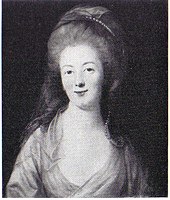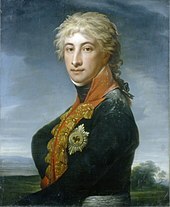Pauline Wiesel

Pauline Wiesel (born May 5, 1778 in Berlin , † September 9, 1848 in Saint-Germain-en-Laye ) was a personality of Berlin society around 1800, friend of Rahel Varnhagen and life companion of Prince Louis Ferdinand of Prussia .
Life
Pauline César (also spelled Zesar or Caesar) was the daughter of the banker Carl Philip César (1726–1795) and his wife Sophie Elisabeth, b. Leveaux (1744-1826). Little is known about her childhood. At the age of fifteen she had her first love affair; henceforth she should have many amours throughout her life. In 1794 she met Rahel Levin (1771–1833), whose closest friend she became. She lived in Berlin until she married Wilhelm Wiesel in 1799. She then traveled to Vienna and Paris with her husband before returning to Berlin for a longer period in 1804 to establish a liaison with Prince Louis Ferdinand of Prussia . Without really gaining social recognition in the Prussian capital, she traveled to Paris two years after the prince's death in the battle near Saalfeld in 1806 in August 1808 and finally settled in Switzerland in 1810 . In 1819 she went to Paris again, where she lived with interruptions until 1828. The following year she moved to Baden-Baden , and finally to Saint-Germain-en-Laye in 1840 , where she died in 1848 at the age of seventy.
Pauline Wiesel did not become famous for her own achievements, but for the exposed role she played in the emotional lives of famous contemporaries. Her strong promiscuity and her free, unconventional nature contributed to the fact that she was able to gain importance as the embodiment of a certain attitude of direct enjoyment of life and unbound self-fulfillment in the spiritual-historical upheaval of the “ saddle time ”. Two circumstances contributed to its popularity at the time and give it its place in today's history : the friendship with Rahel Levin and the love affair with Prince Louis Ferdinand.
family

Marriages and offspring
Pauline César married on May 5, 1799 the Kgl. Prussian war councilor Wilhelm Wiesel (1771–1826). With him she had a daughter:
- Pauline, born April 28, 1800; † May 9, 1800.
In addition, she had a daughter out of wedlock with Paul Andreevich Count Shuvalov (1776–1823):
- Pauline Countess v. Shuvalov, * February 1803; † August 29, 1818.
On October 1, 1828, at the age of fifty, she married the Swiss officer Jules Michel Vincent (1777-1846), who brought two daughters and a son into the marriage.
Famous relatives
Through her mother Elisabeth César, b. Leveaux, Pauline was a niece of the famous Berlin salonière Henriette von Crayen .
Her own niece Caroline Mayer (1777-1860), daughter of her sister Julia Henriette César (1768-1854) and the lawyer Johann Siegfried Wilhelm Mayer (1747-1819), married the poet Jean Paul in 1801 .
Friendship with Rahel Levin

In 1799 Rahel Levin, who later became Mrs. Varnhagen von Ense , got to know Wilhelm Wiesel better. Apparently her friend Wilhelm v. Burgsdorff (1772–1822), a cousin of her former lover, Count Finckenstein (1772–1811), wanted to pair them up with Wiesel in order to console them about the loss of Finckenstein. Instead, however, the attractive and fun-loving Pauline César fell in love with Wiesel, and they married that same year. When the young couple visited Rahel in Paris in 1801, a friendship quickly developed between the two fundamentally different women:
“Rahel was seven years older than Pauline, inconspicuous, of unstable health and a considerable fear of the dangers of her time, but of outstanding understanding and empathy, a woman who approached other people smart and free of prejudice at the same time - at the same time very curious. Pauline almost embodied the opposite, she was young and full of self-confidence, gorgeous and lively, if not of classic beauty, full of energy, robust, spontaneous, humorous. "
Pauline soon became a regular guest in Rahel's attic apartment on Jägerstrasse in Berlin. “Ralle” and “Schwan” - these nicknames the two women had given each other in a combination of physiognomy and coquetry - seemed to complement each other ideally in their differences: Rahel always looked somewhat admiringly at the freshness and immediacy with which Pauline looked at life (and the men) approached; for Pauline, on the other hand, Rahel's sensible advice, but also her fine empathy, was often the last refuge when things got all too confused in her private life. Interestingly, it was the capricious, intellectually simple Pauline with whom Rahel had a particularly intensive and informative correspondence. Rahel deeply characterized their mutual essential relationship in a famous passage:
“ Nature wanted to make one of us, and it had to make two; drum is it for me, and I am her loving of others because of what she is never quick as I that not the courage, and not happiness. "
After Prussia's defeat by Napoleon in 1807, the friendship between the two loosened increasingly. Although they saw each other regularly on trips, for example in Paris in 1815, where Karl August Varnhagen von Ense was on business; But their contact remained sporadic, especially since Rahel's salon had closed its doors after the double battle at Jena and Auerstedt in 1806. It was not until 1832 - Rahel had been running a salon again since the 1820s - did they meet again in Berlin for a long time; but the previous familiarity no longer appeared. Pauline's obstinacy and Rahel's emotionality no longer wanted to get along well in old age.
Affair with Prince Louis Ferdinand

When and where Pauline met Prince Louis Ferdinand of Prussia (1772–1806) is not certain. It is likely, however, that they met for the first time in 1803 in Rachel's salon, to whose habitués the prince also belonged, and that they soon felt drawn to each other. Louis Ferdinand, "the darling of the comrades, the idol of beautiful women", was certainly the most popular Hohenzollern prince at the time:
“His personal charisma was remarkable. Both men and women downright adored him. Both sexes found him beautiful and noble. He was a blond giant, six feet tall, a great athlete and hunter, a committed officer, a talented musician, intelligent, curious, cosmopolitan, and surprisingly free from the pretense of class. "
However, Louis, who had always had an exciting love life, already had a partner in Henriette Fromm (1783–1828 [?]), With whose existence Pauline had to come to terms with better or worse. As usual, Pauline also had her admirers, including the diplomats Karl Gustav Brinckmann and Friedrich Gentz . Her relationship with the prince was characterized by tension from the start: Louis (“Loulou”) was probably primarily looking for quick erotic pleasure in Pauline; Pauline (“Pölle”) hoped for her own emotional closeness and also the social legitimation of her relationship, which was not only frivolous, but was largely considered improper. The intellectual gap between the two will not have played an insignificant role either. Towards the end of 1805 the mood between them reached a low point; Pauline even wrote a suicide note.
In the following year, however, the relationship improved again, which was not least thanks to Rahel's mediation. Now it was Prince Louis who even demanded Pauline's divorce from her little beloved husband, while on the other hand Henriette became more and more jealous and even threatened to officially introduce her children from the relationship with Louis to his sister, Princess Luise Radziwill . Pauline and Louis exercised restraint for the time being, but their mutual affection had grown so deep that Pauline seriously wished her lover had a child.
However, this wish did not come true, just as the usual tense financial situation of the two would have improved. Prince Louis, whom his father, Prince Ferdinand of Prussia , held on a material lead, had long been in debt - so high that he occasionally even had to borrow money from Pauline. When the Fourth Coalition War broke out with France in August 1806 , Prince Louis, the bearer of hope for the outdated Prussian army, went to the front as commander of the vanguard, where he was at the age of 34 on October 10 near Saalfeld , in the first armed conflict of the war fell.
According to Rachel's testimony, Pauline was badly hit by the prince's death. Immediately afterwards, she is said to have thought of suicide. In the end she came back to herself, but had to accept that her place in Berlin society could no longer be held, especially since the liberalism and open-mindedness of Rahel's time quickly came to an end with the defeat of 1806/1807. An attempt to seek economic support from the brother of her fallen friend, Prince August of Prussia , was unsuccessful. Eventually she left Berlin and sought happiness in the arms of new lovers. With an annuity from Count Shuvalov, with whom she had an affair at the beginning of the 19th century, she was more or less secured later.
Survival
Most of the handwritten letters from and to Pauline Wiesel as well as other life testimonies in the form of anecdotal records are in the Varnhagen Collection , whose manuscripts are currently stored in the Jagiellońska Library in Cracow due to being relocated during the war.
The Swiss composer Roland Moser wrote the work Rahel and Pauline in 2007 . Music theater (letter scenes) presented, the focus of which is on the intimate correspondence between Rahel Varnhagen and Pauline Wiesel in Berlin at the beginning of the 19th century. The main role is played by a mezzo-soprano (Varnhagen), alongside an actress (Wiesel), an actor (narrator) and five instruments. An afterword comes from Imre Kertész . First performance September 12, 2007 in the Lucerne Theater as part of the Lucerne Festival . Commissioned by Pro Helvetia .
literature
- Rahel Levin Varnhagen: Correspondence with Pauline Wiesel. Edited by Barbara Hahn and Birgit Bosold. Munich 1997 ( Google books ).
- Barbara Hahn u. a. (Ed.): Pauline Wiesel's love stories. Correspondence with Karl Gustav von Brinckmann, Prince Louis Ferdinand von Preussen, Friedrich Gentz and others. Beck, Munich 1998.
- Petra Wilhelmy: The Berlin Salon in the 19th Century. Berlin u. a. 1989.
- Nina Hess: The swan. The life of Pauline Wiesel. Berlin 1994.
- Barbara Hahn: Pauline Wiesel - a biographical sketch. In: Correspondence. (see above), pp. 722-728.
Web links
- Literature by and about Pauline Wiesel in the catalog of the German National Library
- Ärtbären, dik and runt. Rahel Varnhagen and Pauline Wiesel write to each other : Essay by Carola Stern , in: Die Zeit No. 13/1998.
Individual evidence
- ↑ See Hess, p. 25.
- ↑ Quoted after Hess, p. 75.
- ↑ So Fontane in his poem Prince Louis Ferdinand , in: Complete Romane… , Vol. 6, Munich ³1995, p. 224.
- ↑ See Hess, p. 33.
- ↑ See Hannah Arendt , elements and origins totaler Herrschaft , Munich 1986, pp. 141–169.
| personal data | |
|---|---|
| SURNAME | Wiesel, Pauline |
| BRIEF DESCRIPTION | Girlfriend of Rahel Varnhagen |
| DATE OF BIRTH | May 5, 1778 |
| PLACE OF BIRTH | Berlin |
| DATE OF DEATH | September 9, 1848 |
| Place of death | Saint-Germain-en-Laye |